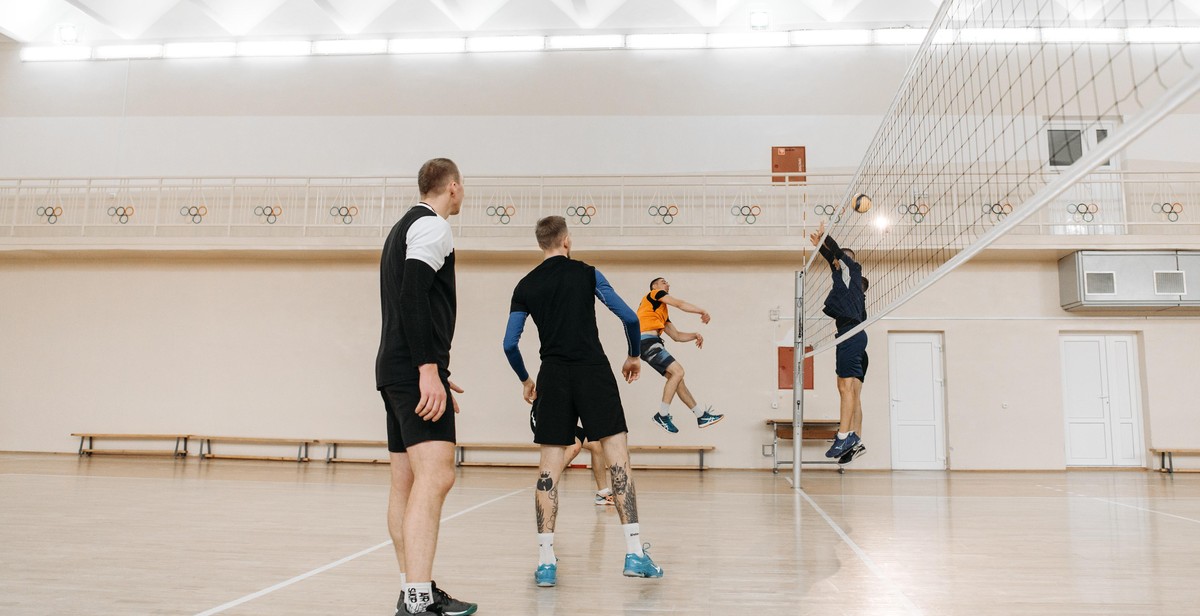How to Block a Volleyball Solo: Techniques and Timing for Effective Solo Blocking
As a professional volleyball player with years of experience, I know how important it is to have a solid blocking game. Solo blocking, in particular, is a key skill that can make or break a game. It involves jumping up to block the ball at the net without any assistance from teammates, which requires not only physical strength but also strategic planning and precise timing.
In this article, I will be sharing tips and techniques for effective solo blocking, including footwork, hand positioning, and body alignment. I’ll also cover the importance of timing and how to read your opponent’s hitting tendencies to anticipate where and when to block.
Whether you are a beginner or an experienced player looking to improve your blocking game, this guide will provide you with valuable insights and practical advice on how to become a more effective solo blocker.
What You’ll Learn:
- The basics of solo blocking in volleyball
- Footwork and hand positioning for effective blocking
- Body alignment and balance
- Timing and reading your opponent’s hitting tendencies
- Common mistakes to avoid when solo blocking
By the end of this article, you’ll have a better understanding of what it takes to be a successful solo blocker and be equipped with the tools to take your game to the next level.

Understanding Volleyball Solo Blocking
Volleyball solo blocking is a defensive technique used in volleyball to stop the opposing team from successfully executing an attack. It involves a player jumping up to the net and blocking the ball from the opposing team’s hitter. Solo blocking is an essential skill for any volleyball player who wants to excel in the game.
Why is Volleyball Solo Blocking Important?
Volleyball solo blocking is critical because it can disrupt the opposing team’s offensive rhythm and give your team an advantage. A successful solo block can result in a point for your team or force the opposing team to change their attack strategy. It can also boost your team’s morale and momentum, leading to more successful plays.
Moreover, solo blocking is an effective way to prevent the opposing team’s hitters from hitting the ball to open spaces on your side of the court. It also helps take pressure off your team’s backcourt defenders and allows them to focus on digging the ball if the block is unsuccessful.
The Technique of Volleyball Solo Blocking
The technique of volleyball solo blocking involves several key elements, including footwork, body positioning, and timing. To perform a successful solo block, you need to:
- Move quickly to the net and jump straight up
- Place your hands over the net and penetrate into the opposing team’s side
- Keep your eyes on the ball and the hitter’s hitting shoulder
- Press your hands and arms over the net, forming a wall to block the ball
Timing is crucial in solo blocking. You need to time your jump correctly so that you reach the peak of your jump at the same time as the hitter. This way, you can block the ball and prevent it from crossing the net to your side of the court.
| Common Mistakes in Volleyball Solo Blocking |
|---|
| Jumping too early or too late |
| Not penetrating the net enough |
| Not watching the hitter’s shoulder |
| Not pressing over the net with hands and arms |
By avoiding these common mistakes and mastering the technique of solo blocking, you can become a valuable asset to your team and help lead them to victory.

Techniques for Effective Volleyball Solo Blocking
Blocking is one of the most important defensive skills in volleyball. As a solo blocker, it is essential to have the right techniques and timing to effectively block the opposing team’s attacks. Here are some techniques to help improve your solo blocking:
Proper Footwork and Positioning
Start by positioning yourself in the middle of the net, with your feet shoulder-width apart. As the ball is being served, take a small step forward to get into a ready position. Keep your body weight forward and your knees bent, ready to jump at any moment.
Reading the Hitter’s Approach
As the hitter approaches the net, watch their body language and the position of their arms. This will give you an indication of where they are likely to hit the ball. Try to anticipate their movements and position yourself accordingly.
Timing the Jump
Timing your jump is crucial for effective solo blocking. You should jump just as the hitter is about to make contact with the ball. This will give you the best chance of blocking their attack.
Penetrating the Net
Once you have jumped, it is important to reach over the net as far as possible to block the ball. This is known as penetrating the net. The higher you can reach, the more effective your block will be.
Getting Your Hands Over the Net
When blocking, it is important to get your hands over the net and into the opponent’s side of the court. This will help to prevent the ball from crossing the net and scoring points.
Staying Balanced and Controlled
Finally, it is important to stay balanced and controlled throughout the blocking process. Keep your feet firmly planted on the ground and use your core muscles to maintain your balance.
By following these techniques, you can improve your solo blocking skills and become a more effective defender on the volleyball court.

Practicing Volleyball Solo Blocking
Improving your solo blocking skills in volleyball requires consistent practice and dedication. Here are some drills that can help you develop your technique:
1. Wall Blocking
Find a wall or vertical surface and stand about three feet away from it. Practice jumping and reaching to touch the wall at the highest point possible. This drill helps you work on your timing and jump height, which are critical components of successful solo blocking.
2. Shadow Blocking
Stand across the net from a teammate and mimic their movements as they hit the ball. This drill helps you focus on the hitter’s approach and timing, which can help you anticipate where the ball will go and position yourself for a successful block.
3. One-on-One Drills
Practice solo blocking against a teammate or coach. This drill helps you work on your footwork, body positioning, and timing. Make sure to vary the hitter’s approach and shot selection to simulate game situations.
4. Video Analysis
Record yourself during practice or a game and review the footage to identify areas for improvement. Pay attention to your footwork, timing, and positioning during solo blocking attempts.
Incorporating Solo Blocking into Team Practice
Effective solo blocking requires coordination and communication with your teammates. Here are some ways to incorporate solo blocking into team practice:
1. Position-Specific Drills
Set up drills that focus on specific positions, such as middle blocker or outside hitter. This allows players to work on their solo blocking skills in game-like situations.
2. Scrimmages
Include solo blocking in scrimmage situations to give players the opportunity to practice their skills in a competitive setting. Encourage communication between teammates to ensure effective blocking coverage.
3. Feedback and Analysis
Provide feedback to players during practice and review game footage to identify areas for improvement. Encourage players to communicate with each other during solo blocking attempts and work together to make adjustments.
| Benefits of Practicing Volleyball Solo Blocking |
|---|
| 1. Improved timing and jump height |
| 2. Better anticipation of hitter’s approach and shot selection |
| 3. Enhanced coordination and communication with teammates |
By incorporating solo blocking drills into your practice routine and working with your team to develop effective blocking strategies, you can become a more skilled and confident volleyball player.

Common Mistakes in Volleyball Solo Blocking
Blocking in volleyball is an essential part of the game, and solo blocking is an advanced technique that requires precision, timing, and skill. However, even the most experienced players can make mistakes when attempting a solo block. Here are some common mistakes to avoid:
Swinging at the Ball
One of the most common mistakes in solo blocking is swinging at the ball. When you swing at the ball, you lose control of your body and your position on the court. Instead of swinging, focus on staying balanced and stable, and use your hands to direct the ball back to the opponent’s court.
Jumping Too Early or Too Late
Timing is crucial in solo blocking. If you jump too early, you will not be able to reach the ball, and if you jump too late, the ball will already be on your side of the net. To avoid this mistake, practice your timing and pay attention to the hitter’s approach and arm swing.
Not Penetrating the Net
Penetration is the ability to reach over the net and block the ball on the opponent’s side of the court. Many players make the mistake of not penetrating enough, which allows the hitter to hit around the block. To avoid this mistake, focus on reaching over the net and pressing your hands down towards the opponent’s court.
Leaning or Reaching Over the Net
Leaning or reaching over the net is a violation in volleyball and will result in a point for the opposing team. To avoid this mistake, stay on your side of the court and use your vertical jump and arm extension to block the ball.
By avoiding these common mistakes, you can improve your solo blocking technique and become a more effective blocker on the court.

Conclusion
Blocking is a crucial aspect of volleyball, and solo blocking can be a game-changer. By mastering the techniques and timing required for effective solo blocking, you can become a valuable asset to your team and help them win more games.
Techniques to Remember
- Stay low and keep your eyes on the ball
- Use a strong footwork approach to get to the net quickly
- Keep your arms and hands in the right position
- Jump straight up and extend your arms and hands over the net
- Press over the net and penetrate the opponent’s side
Timing is Key
Timing is crucial for effective solo blocking. You need to anticipate the opponent’s attack and jump at the right moment to block the ball. Practice your timing by watching your opponent’s arm swing and body position to predict when they will hit the ball.
Practice Makes Perfect
Mastering solo blocking requires practice and dedication. Incorporate solo blocking drills into your training routine and work on improving your technique and timing. With time and effort, you can become a skilled solo blocker and help your team win more games.
| Remember: | Blocking is not just about stopping the ball, but also about redirecting it to your teammates for a better chance of scoring. |
So, keep these techniques and tips in mind, and practice consistently to become a successful solo blocker.
